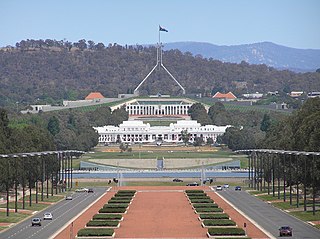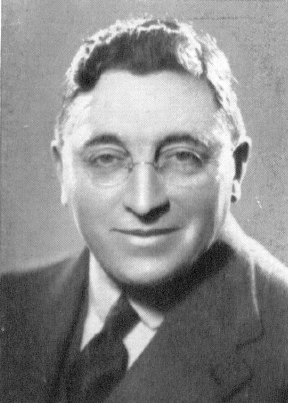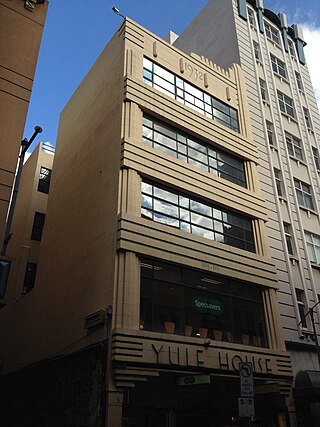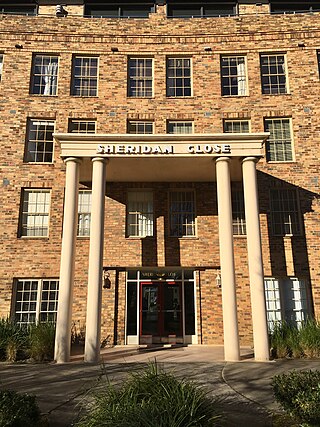
John Smith Murdoch was a Scottish architect who practised in Australia from the 1880s until 1930. Employed by the newly formed Commonwealth Public Works Department in 1904, he rose to become chief architect, from 1919 to 1929, and was responsible for designing many government buildings, most notably the Provisional Parliament House in Canberra, the home of the Parliament of Australia from 1927 to 1988.
Sir Roy Burman Grounds was an Australian architect. His early work included buildings influenced by the Moderne movement of the 1930s, and his later buildings of the 1950s and 1960s, such as the National Gallery of Victoria and the adjacent Victorian Arts Centre, cemented his legacy as a leader in Australian architecture.
Neil Clerehan was an Australian architect and architectural writer.

Percy Edgar Everett,, was appointed chief architect of the Victorian Public Works Department in 1934 and is best known for the striking Modernist / Art Deco schools, hospitals, court houses, office buildings and technical colleges the department produced over the next 20 years.
John and Phyllis Murphy were architects in Australia. Phyllis was also known for her work with wallpaper design and restoration.

Alfred Louis Smith and Arthur Ebden Johnson were architects who designed many public buildings of Melbourne in the classical style.
Walter Richmond Butler, was an Australian architect trained in the Arts and Crafts style, born in Somerset, England.

John Beswicke (1847–1925) was an architect who practiced in Melbourne between the 1870s and 1915.

Joseph Plottel was a British born architect who was active in Melbourne, Australia between 1911 and World War II, working in a range of revival styles, as well as Art Deco in the 1930s. He is best known for the St Kilda Synagogue (1927) and the Footscray Town Hall (1936).
Beverley Ussher was articled to Melbourne architect Alfred Dunn. Dunn was English and had worked for architect Alexander Lauder in Barnstaple, Devon, where he worked with Arts and Crafts movement theorist and practitioner W.R. Lethaby. Through Dunn's English connections, when Ussher completed his architecture articles in Melbourne, he visited England and was introduced to architect Walter Butler. Later Ussher and Butler formed a partnership in Melbourne.

Yule House is a five-story office building situated at 309-311 Little Collins Street, Melbourne, Australia. It was constructed in 1932 from a design by Melbourne-based architecture firm, Oakley & Parkes. Yule House was one of Melbourne’s first commercial buildings to exhibit the Streamline Moderne style of architecture and began the style's rise in popularity throughout the 1930s. The current Yule House stands as a redesigned fireproof replacement of the original, which was destroyed by fire in 1931. William Yule had been the owner of the land since the early 1900s and it remained part of his estate until 1985.
Geoffrey Harley Mewton (1905–1998) was an Australian architect and leading proponent of modern architecture in Melbourne during the 1930s. He is best known for the Woy Woy flats at Elwood, Victoria, amongst the first flat blocks in Melbourne to show the influence of the European Modern movement.
Robert Joseph Haddon (1866–1929) was an England-born architect who practised in Victoria in the 1900s-1910s. He was a major figure in the profession in Victoria, championing the Arts & Crafts in his writing and teaching. He designed some of the most original buildings of the period, featuring restraint, balanced asymmetry and Art Nouveau details.
Acheson Best Overend was an Australian architect. He is best known for the Cairo Flats in Fitzroy, built 1935-6, a daringly Modernist design for Melbourne in the 1930s.

Perrott Lyon Mathieson was an Australian architecture firm based in Melbourne, Australia. Founded by Leslie M Perrott in 1914, the firm was responsible for numerous high-profile projects from the 1920s to the 1990s, and was associated with the Perrott and Lyon architectural families, spanning three generations and eight practitioners.
Guilford Marsh Bell was an Australian architect active following from World War II until his death in 1992. During his early studies Bell travelled extensively, drawing influences that were later reflected for his projects. Bell worked prolifically both individually and in various partnerships, allowing him to produce many architectural works. Uncommonly, Bell contributed to local and interstate projects including homesteads, pavilions, suburban houses, large commercial and industrial establishments. Bell died in Melbourne in 1992. His latest practice continues under the directorship of Graham Fisher.

Berg and Alexandra was an Australian architecture firm from 1962 to 1996, based in Chelsea House, on Flemington Road in North Melbourne. The firm was formed by a partnership between two Melbourne architects Raymond Berg, born in 1913 in South Melbourne, and Douglas Alexandra, born in 1922 in Shepparton, Victoria. Berg retired in 1983 and died five years later, with Alexandra retiring in 1996 and selling the practice to Hudson and Wardrop. Berg and Alexandra were among the first post-war Australian architects to produce modernist works. They were heralded for their simple, stripped back designs that broke away from ‘the old familiar features’ of Australian Architecture.
Douglas Alexandra was an Australian architect, whose works were an important contribution to modernist architecture in Melbourne, Australia.

Sheridan Close is a low-rise apartment complex situated on 485–489 St Kilda Road, Melbourne, Victoria, Australia. It has direct access onto Fawkner Park at the rear of the building. It was designed by the architect Sir Bernard Evans, who later became Lord Mayor of Melbourne, and was built by Prentice Builders. Sheridan Close is described as "a stylistic hybrid", combining a concave regency façade, Georgian proportioned windows and Art Deco influences, with serrated side elevations to ensure views of St Kilda Road.
Marcus Martin (1893–1981) was an Australian architect. He was an associate of the Royal Institute of British Architects, fellow of Royal Institute of Architects, and honorary secretary to the Royal Victorian Institute of Architects.














